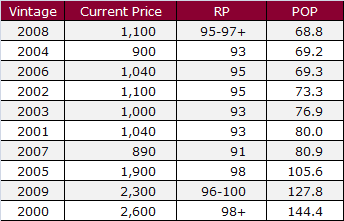Although the First Growths – and Mouton in particular – continue to see brisk trade on the exchange, the last few months have seen the market broaden to encompass a wider group of Cru Classe – including Leoville Las Cases. Given the burgeoning prices of the First Growths, it seems likely that 2011 will see Chinese buyers expand their attention to include other strong brands, or even regions. In recent weeks there has been some suggestion that Burgundy will be next in line to benefit from Asian interest; however, Las Cases and its fellow Super Seconds may also represent attractive alternatives for brand-conscious buyers.
On average, physical vintages of Las Cases from 2000 onwards have increased in value by 22% over the past year. And though this pales in comparison with the rapid price appreciation seen by the First Growths over the same period, Las Cases is finally showing signs of life.
Despite the Second Growth's positive gains, prices for recent vintages of the Premier Crus (2000-2009) have risen to such an extent that corresponding vintages of Las Cases are trading at just 21% of the price. If we remove Lafite from the equation and only look at the last ten physical vintages, Las Cases is, on average, 26% of the price of a First Growth – down from 30% in May 2010, and 55% in early 2004. This decrease in relative value (rather than price) further emphasises Las Cases's strong potential value, should it continue to see increased demand. (Read last year's blog on Las Cases's value relative to the First Growths).
As you can see from the table below, which shows each vintage's current price, Parker score and price-over-points ratio, the 2008, 2006 and 2002 all boast 95 points and above and are available at £1,100 and under (12x75cl).

Source: erobertparker.com
A wine’s POP score is its price-over-points ratio, our loose measure of value. It is calculated by dividing the price of a nine-litre case of wine by a shortened 20-point Parker score. We calculate this 20-point score by simply subtracting 80 from the official Parker rating, on the basis that any wine under 80 points is unlikely to attract a secondary market. In theory, the lower the POP score, the better value a wine is.





